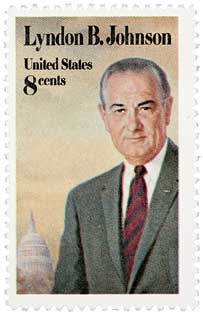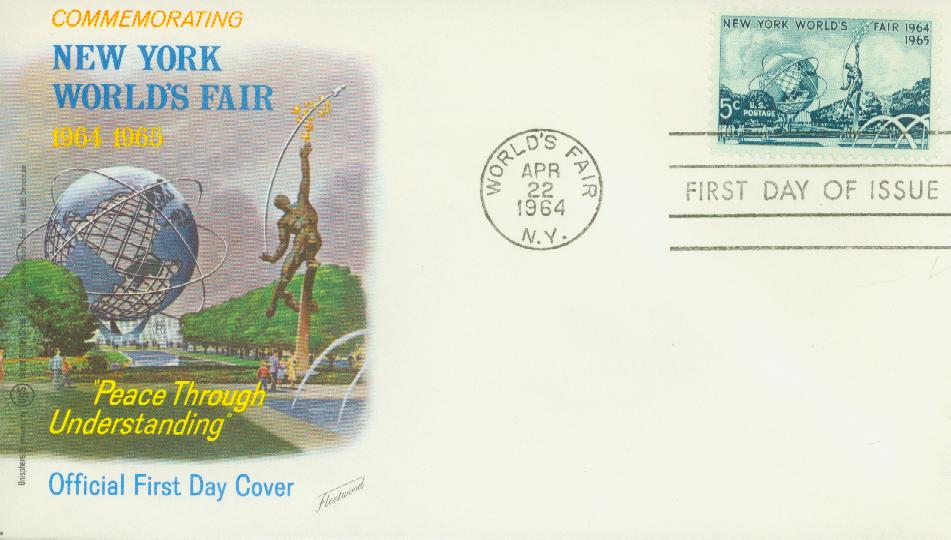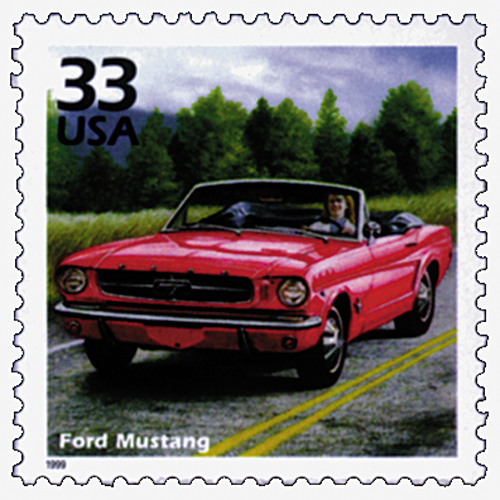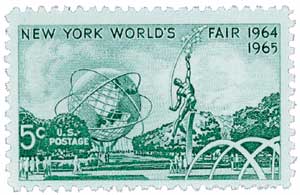
# 1244 PB - 1964 5c New York World's Fair
Â
5¢ New York World’s Fair
City: New York, NY
Quantity: 145,700,000
Printed by: Bureau of Engraving and Printing
Printing Method: Rotary Press
Perforations: 11 x 10 1/2
Color: Blue green
Opening Of The 1964 New York World’s Fair
Long before Flushing Meadows was built, the site of the park was a natural wetland that would flush the runoff from the nearby bay. It had also housed a Dutch Settlement named after the village of Vlissingen, which means flushing.

In the early 1900s the area was made into the Corona Ash Dumps, which F. Scott Fitzgerald called “a valley of ashes†in The Great Gatsby. Eventually plans developed to turn the area into a grand park, and the site was overhauled to house the 1939/1940 World’s Fair. (This the second World’s Fair held in New York, the first being held in 1853-54 in present-day Bryant Park.) The three New York World’s Fairs were the only international expos to span two years, while all others were just for one.
Businessmen with fond childhood memories of the 1939 World’s Fair developed plans for the 1964/65 World’s Fair. They gained support with promises of an economic boom and surge in tourism. While the fair received approval from the Eisenhower Commission, it was not officially sanctioned by the Bureau of International Expositions (neither was the 1939 fair). In fact, the BIE requested that its member nations not participate, and resulted in the absence of Canada, Australia, and the Soviet Union, among other nations. However, several nations with smaller economies were honored to join, including Spain, Vatican City, Japan, Mexico, Sweden, Austria, Denmark, Thailand, Philippines, Greece, and Pakistan, and Ireland.

The fair officially opened on April 22, 1964. The day’s festivities included speeches from the fair’s organizers, Nelson Rockefeller, and President Lyndon B. Johnson. As President Johnson stated, “The Fair represents the most promising of our hopes. It gathers together from 80 countries the achievements of industry; the health of nations; the creations of man. This Fair shows us what man at his most creative and constructive is capable of doing. But unless we can achieve the theme of this Fair, ‘Peace Through Understanding’; unless we can use our skill and our wisdom to conquer conflict, as we have conquered science – then our hopes of today, these proud achievements, will go under in the devastation of tomorrow.â€
One of the fair’s most popular international exhibits was Michelangelo’s Pietà , on display at the Vatican Pavilion. There was also an ancient column from Jordan that still stands today.

The fair’s US Pavilion focused on President Johnson’s “Great Society†and included a 15-minute ride through history and a tribute to John F. Kennedy who had broken ground for the pavilion before his death. The US Space Park sponsored by NASA had several full-scale models as well as actual spacecraft, including a Gemini capsule, Aurora 7, an X-15 aircraft, a Lunar Excursion Module, as well as Mariner and Explorer probes.
Twenty-four states were represented at the fair, with Wisconsin bringing the “World’s Largest Cheese†and Florida bringing an array of wildlife. There were also New York City and Bourbon Street Pavilions.

A major part of the fair was the presence of American industry. Ford introduced its Mustang and IBM offered many people their first interaction with a computer. The Sinclair Oil Corporation sponsored a Dinoland exhibit featuring nine life-size dinosaur replicas. And Walt Disney created four animatronics shows, including the popular “It’s a Small World,†which was a salute to UNICEF and the children of the world.
More than 51 million people attended the 1964/65 World’s Fair, far less than the estimated 70 million planners hoped for to cover the costs of its operation. However, the site of the fair, Flushing Meadows Park, was seen as a major improvement to the city. Several of the fair’s buildings still stand and serve as museums.
Click here for more pictures and stories from the fair.
Â
Â
5¢ New York World’s Fair
City: New York, NY
Quantity: 145,700,000
Printed by: Bureau of Engraving and Printing
Printing Method: Rotary Press
Perforations: 11 x 10 1/2
Color: Blue green
Opening Of The 1964 New York World’s Fair
Long before Flushing Meadows was built, the site of the park was a natural wetland that would flush the runoff from the nearby bay. It had also housed a Dutch Settlement named after the village of Vlissingen, which means flushing.

In the early 1900s the area was made into the Corona Ash Dumps, which F. Scott Fitzgerald called “a valley of ashes†in The Great Gatsby. Eventually plans developed to turn the area into a grand park, and the site was overhauled to house the 1939/1940 World’s Fair. (This the second World’s Fair held in New York, the first being held in 1853-54 in present-day Bryant Park.) The three New York World’s Fairs were the only international expos to span two years, while all others were just for one.
Businessmen with fond childhood memories of the 1939 World’s Fair developed plans for the 1964/65 World’s Fair. They gained support with promises of an economic boom and surge in tourism. While the fair received approval from the Eisenhower Commission, it was not officially sanctioned by the Bureau of International Expositions (neither was the 1939 fair). In fact, the BIE requested that its member nations not participate, and resulted in the absence of Canada, Australia, and the Soviet Union, among other nations. However, several nations with smaller economies were honored to join, including Spain, Vatican City, Japan, Mexico, Sweden, Austria, Denmark, Thailand, Philippines, Greece, and Pakistan, and Ireland.

The fair officially opened on April 22, 1964. The day’s festivities included speeches from the fair’s organizers, Nelson Rockefeller, and President Lyndon B. Johnson. As President Johnson stated, “The Fair represents the most promising of our hopes. It gathers together from 80 countries the achievements of industry; the health of nations; the creations of man. This Fair shows us what man at his most creative and constructive is capable of doing. But unless we can achieve the theme of this Fair, ‘Peace Through Understanding’; unless we can use our skill and our wisdom to conquer conflict, as we have conquered science – then our hopes of today, these proud achievements, will go under in the devastation of tomorrow.â€
One of the fair’s most popular international exhibits was Michelangelo’s Pietà , on display at the Vatican Pavilion. There was also an ancient column from Jordan that still stands today.

The fair’s US Pavilion focused on President Johnson’s “Great Society†and included a 15-minute ride through history and a tribute to John F. Kennedy who had broken ground for the pavilion before his death. The US Space Park sponsored by NASA had several full-scale models as well as actual spacecraft, including a Gemini capsule, Aurora 7, an X-15 aircraft, a Lunar Excursion Module, as well as Mariner and Explorer probes.
Twenty-four states were represented at the fair, with Wisconsin bringing the “World’s Largest Cheese†and Florida bringing an array of wildlife. There were also New York City and Bourbon Street Pavilions.

A major part of the fair was the presence of American industry. Ford introduced its Mustang and IBM offered many people their first interaction with a computer. The Sinclair Oil Corporation sponsored a Dinoland exhibit featuring nine life-size dinosaur replicas. And Walt Disney created four animatronics shows, including the popular “It’s a Small World,†which was a salute to UNICEF and the children of the world.
More than 51 million people attended the 1964/65 World’s Fair, far less than the estimated 70 million planners hoped for to cover the costs of its operation. However, the site of the fair, Flushing Meadows Park, was seen as a major improvement to the city. Several of the fair’s buildings still stand and serve as museums.
Click here for more pictures and stories from the fair.
Â






